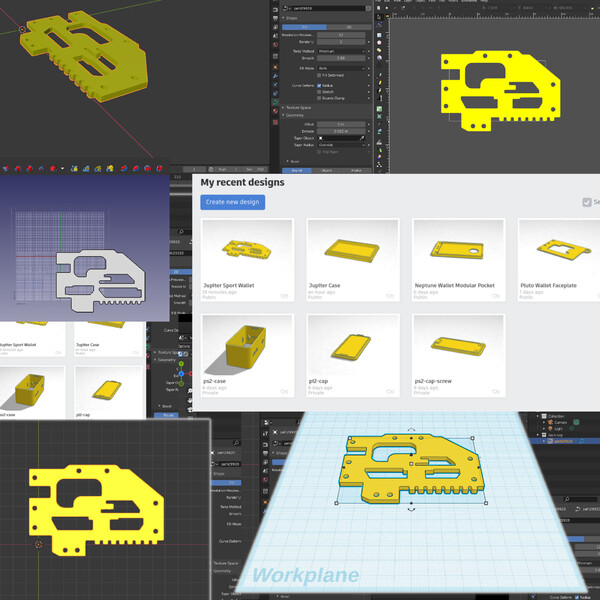3D Printing: A Look At Strange Wallets
Wednesday • August 18th 2021 • 8:26:56 pm
I took the Blender Doughnut Tutorial today,
and the first level is not bad at all - Keyboard Shortcuts and Little Buttons.
I have been looking into Blender as a backup to FreeCAD,
but also it is good for the soul to develop patience for special need programs.
I have spent a little bit more time in Inkscape, a 2D program,
it has very good features.
And I have also spent a moment thinking about paper,
as it is reasonable to draw a design on paper.
It will require conversion to SVG,
and in some cases can be used in a 3D sculpting program.
My initial designs were squares,
the latest design, is me drawing with a line tool.
Not a free hand tool,
but a tool that draws straight lines.
Now, by pressing the control key,
you are only allowed to make angles in 15 degree increments.
The designs almost design themselves,
this is within Inkscape.
It is a tool,
that prevents crooked doodles.
The latest design that is shown in the title picture,
is mostly a random arrangement of 2D shapes.
It is a study,
in what a more deliberate design process would feel like.
Inkscape in particular has helpful tools for arranging objects evenly,
evenly distributing spaces between objects.
When a 2D design is imported to FreeCAD, it can be converted to a sketch,
but the sketch will need hundreds of constraints, 700 in this case.
But the program demands can be ignored,
so as long as all the objects that will later become holes by means of Boolean Cuts, are solid paths.
I had them set as lines and FreeCAD would get confused,
a hole in the SVG will not translate to a hole in FreeCAD, it will become an object that needs to go through the Boolean Cut process.
Which is where Blender comes in,
blenders ability to convert an SVG into a 3D object is a matter of setting the imported SVG object extrusion value under Geometry,
In my case here it is 2mm,
Blender can export the object, but in case of TinkerCAD it must be scaled a 1,000 times during export.
Blender's default scene is in meters,
it is just easier to enter 1000 during export then mess with the settings.
By using Blender with a Slicer that generates gcode that 3D printers and other machines understand,
it is hard to see any limitations to any kind of design.
FreeCAD seems to be a more serious program,
it is meant to create tools and parts.
Blender, takes the concept to the maximum,
and far beyond manufacturing.
There was a cartoon that I watched a few times when I was little,
it was called Enchanted Pencil.
Three minutes fifty seconds into the cartoon,
a Gnome appears for no reason, and hands the main character a magical pencil.
The boy then copies a tattoo on a nearby sleeping admiral,
and the drawing magically appears in reality.
3D pens that extrude the same kind of filament that 3D printers use do exist,
but making 3D drawings free hand is a different process.
It is very artistic through, and the filament work does smooth out with a hot knife and some filling,
it is just that one can't make perfect copies.
But that is what 3D modeling of real world objects feels like to me,
it is like using a magical pencil.
It seems almost everyone is using wallets to refine their work flow,
it certainly makes for an interesting hobby.
I bought a little CR2030 battery,
and while it was still in packaging I pierced it with a pin and slid in a 5mm led.
It has been on all afternoon,
I can tell the green LED needs more juice.
I just jabbed in a red one in there and it looks fantastic,
all it takes is a pair of calipers to create a useless wallet feature, that will make all the difference.
I've noticed many wallet designs have little little ports for MicroSD cards,
and even card adapters.
I continue using elastic string during my initial research,
that's what the round holes are for in the title image.
But I've notices people using rubber washers or bands to create simple hinges,
and a handful of designs takes that extra step and feature an actual mechanical hinge.
Creating a proper hinge is simple math,
and a hinge can be printed per-assembled which is yet another fantastic tangent.
My favorite idea in the world of wallets,
is of course Generative Wallets.
A program would follow simple logic to outline an SVG design,
it would randomly choose from ideas about each of the corners, rounded, exposed, square with an extrusion, etc.
With a handful of randomly set parameters,
the wallet design would emerge out of random chaos.
Moreover once could display nine wallets,
and allow the user to choose which of the features look most fetching.
And then re generate nine new designs,
that select for what the features previously picked.
Borrowing from the process of evolution,
though I prefer non-interactive product generation, myself.
In closing, I want to hold this up as an example of Real Education,
something that can be learned in 7th grade, and mastered by high school.
Even though this is just printing,
it is also a lesson in business.
It shows a young mind that there is a small gap between an original invention,
and an online store.
High school graduation, should end with all the students being equipped with an independent business,
most of the time it would be multiple co-founders, as it is easier - but that is not the rule.
And here the students would see that they don't need to graduate into more debt and more poverty,
but rather have something that pushes all the fears of post-graduation back.
